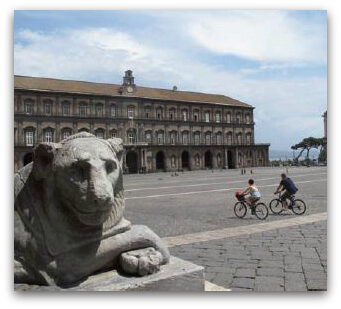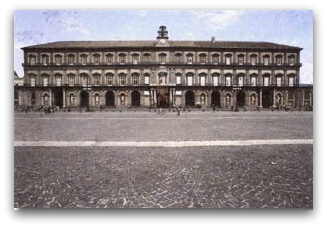
- Piazza del Plebiscito with Palazzo Reale, detail
Piazza del Plebiscito, once called "Largo di Palazzo" (Palace Square), was recently made into a pedestrian precinct. It is bounded on the east by the 169-metre long Royal Palace (that hostes the royal apartments, the Court theatre and the Vittorio Emanuele III National Library) and on the west by the neoclassical colonnade of the Church of San Francesco di Paola built by Pietro Bianchi in 1817; on the south there is Palazzo Salerno by Francesco Scuro (XVIII century) and on the north Palazzo della Prefettura, realised by Leopoldo Laperuta in 1815. At the centre two equestrian statues by Antonio Canova depicting Carlo di Borbone and Ferdinando I (the King sculpture is a work of Antonio Calì) rise.
The area is not only full of buildings of artistic importance such as the San Carlo Royale Theatre one of the oldest theatres, the elegant Umberto I Gallery with its imposing iron and glass roof, the royal residence and fortress Castel Nuovo (that hostes the Public Museum), built by the Angevins - it is also an ideal shopping area.
This is still, after many centuries, the political and administrative centre of the city: the Town Council meet in the Barons' Hall in Castel Nuovo, the nearby Palazzo San Giacomo is the city's Town Hall, and the municipal council meet there. Via Medina, full of historical and artistic buildings, leads to the historical centre of the city.
